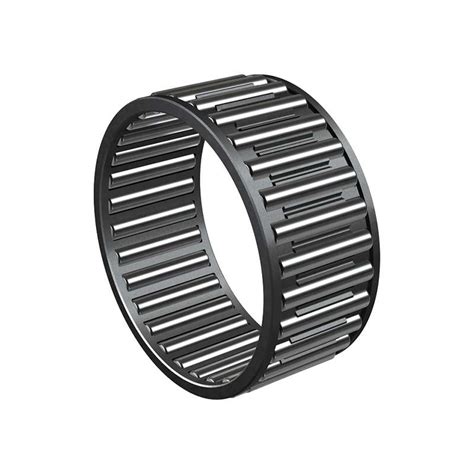Needle Roller Bearings: The Precision Jewels of Rotating Applications
Introduction
Needle roller bearings, aptly named for their slender, cylindrical shape, stand as the epitome of precision engineering in the field of rotating components. Their compact design, exceptional load-carrying capacity, and remarkably low friction make them the preferred choice for a vast array of industrial applications, from high-speed machinery to aerospace systems.
Anatomy and Function of Needle Roller Bearings
| Component | Function |
|---|---|
| Inner Ring | Supports the shaft |
| Outer Ring | Houses the needle rollers |
| Needle Rollers | Small, cylindrical rolling elements that carry the load |
| Cage | Separates and guides the needle rollers |
Needle roller bearings operate on the principle of rolling contact, where the needle rollers rotate smoothly between the inner and outer rings. This design minimizes friction, reduces heat generation, and enhances bearing life. Their compact size allows for a high number of needle rollers to be packed within a given space, resulting in exceptional load-carrying capacity despite their small footprint.

Types of Needle Roller Bearings
The versatility of needle roller bearings is reflected in the wide range of types available, each tailored to specific application requirements:
-
Drawn Cup Needle Bearings: Economical and compact, ideal for applications with moderate loads and speeds.
-
Drawn Cup Needle Bearings with Flange: Provides axial stability and prevents axial displacement of the shaft.
-
Machined Needle Roller Bearings: Offer higher load capacities and speeds, with more precise dimensional tolerances.
-
Needle Thrust Bearings: Designed to handle purely axial loads, commonly used in transmissions and clutches.
-
Combined Needle Roller Bearings: Hybrid bearings that combine the advantages of needle roller bearings with other bearing types, such as ball or cylindrical roller bearings.
Benefits of Needle Roller Bearings
Incorporating needle roller bearings into rotating applications offers a multitude of advantages, including:
-
Compact Size: The small size of needle rollers allows for space savings in equipment designs.
-
High Load Capacity: Despite their small size, needle roller bearings can withstand significant radial and axial loads.
-
Low Friction: The rolling motion of the needle rollers minimizes friction, reducing heat generation and power loss.
-
Reduced Maintenance: The sealed design of many needle roller bearings eliminates the need for frequent lubrication and maintenance.
-
Long Life: The high-quality materials and precision manufacturing of needle roller bearings ensure extended bearing life.
Applications of Needle Roller Bearings
The versatility of needle roller bearings extends to a wide range of applications across multiple industries:

-
Automotive: Transmissions, differentials, and steering systems
-
Industrial Machinery: Conveyors, robots, and CNC machines
-
Aerospace: Aircraft engines and landing gear
-
Medical Equipment: Surgical instruments and imaging systems
-
Consumer Products: Appliances, power tools, and bicycles
Common Mistakes to Avoid When Using Needle Roller Bearings
To ensure optimal performance and longevity of needle roller bearings, it is important to avoid common pitfalls:
-
Overloading: Exceeding the specified load capacity can shorten bearing life.
-
Incorrect Installation: Proper installation is crucial to avoid damage to the bearing or premature failure.
-
Lack of Lubrication: Adequate lubrication is essential for reducing friction and heat generation.
-
Misalignment: Misalignment between the shaft and bearing housing can lead to uneven loading and premature wear.
-
Contamination: Keeping the bearing environment clean is vital to prevent premature failure.
Why Needle Roller Bearings Matter
The precision engineering and exceptional performance of needle roller bearings have made them indispensable in a wide range of industries. Their ability to withstand high loads, minimize friction, and provide long life is crucial for ensuring the smooth operation and durability of machinery, equipment, and systems.


Call to Action
If you are seeking to optimize the performance and efficiency of your rotating applications, consider incorporating needle roller bearings into your designs. Their compact size, exceptional load-carrying capacity, and low friction make them the ideal choice for a wide range of applications.
Strategies for Effective Use of Needle Roller Bearings
-
Choose the right type: Determine the appropriate type of needle roller bearing based on load, speed, and space constraints.
-
Ensure proper installation: Follow the manufacturer's instructions for proper installation and alignment.
-
Maintain lubrication: Regularly lubricate the bearing to reduce friction and heat generation.
-
Avoid overloading: Exceeding the specified load capacity can lead to premature failure.
-
Monitor regularly: Periodically inspect the bearing for signs of wear or damage.
Tips and Tricks for Working with Needle Roller Bearings
-
Use a cage: Cages help separate and guide the needle rollers, reducing friction and wear.
-
Lubricate with precision: Use the recommended lubricant type and quantity to optimize performance.
-
Protect from contamination: Seal the bearing environment to prevent contamination from dust, dirt, or moisture.
-
Consider using a thrust washer: Thrust washers can help distribute axial loads and extend bearing life.
-
Store properly: Store needle roller bearings in a clean, dry environment to prevent corrosion or damage.
Humorous Stories and Lessons Learned
Story 1: The Case of the Noisy Robot
A robotic manufacturing line was experiencing excessive noise and vibration. Upon inspection, it was discovered that the needle roller bearings in the robot's joints had not been properly lubricated. The resulting friction and wear had damaged the bearings, causing them to make a cacophony of grinding and squeaking sounds. The lesson learned: Regular lubrication is essential for the smooth and quiet operation of needle roller bearings.
Story 2: The Adventure of the Overloaded Conveyor
A conveyor belt in a warehouse was constantly breaking down due to bearing failures. After examining the system, it was determined that the conveyor was overloaded beyond the capacity of the needle roller bearings. The excessive load caused the bearings to fail prematurely, leading to costly downtime and lost productivity. The lesson learned: Avoid overloading needle roller bearings to prevent premature failure and ensure optimal performance.
Story 3: The Tale of the Misaligned Shaft
In a high-speed machine, misalignment between the shaft and bearing housing caused the needle roller bearings to wear unevenly. This led to increased vibration, noise, and ultimately, catastrophic bearing failure. The lesson learned: Proper alignment is crucial for the longevity and reliability of needle roller bearings.

